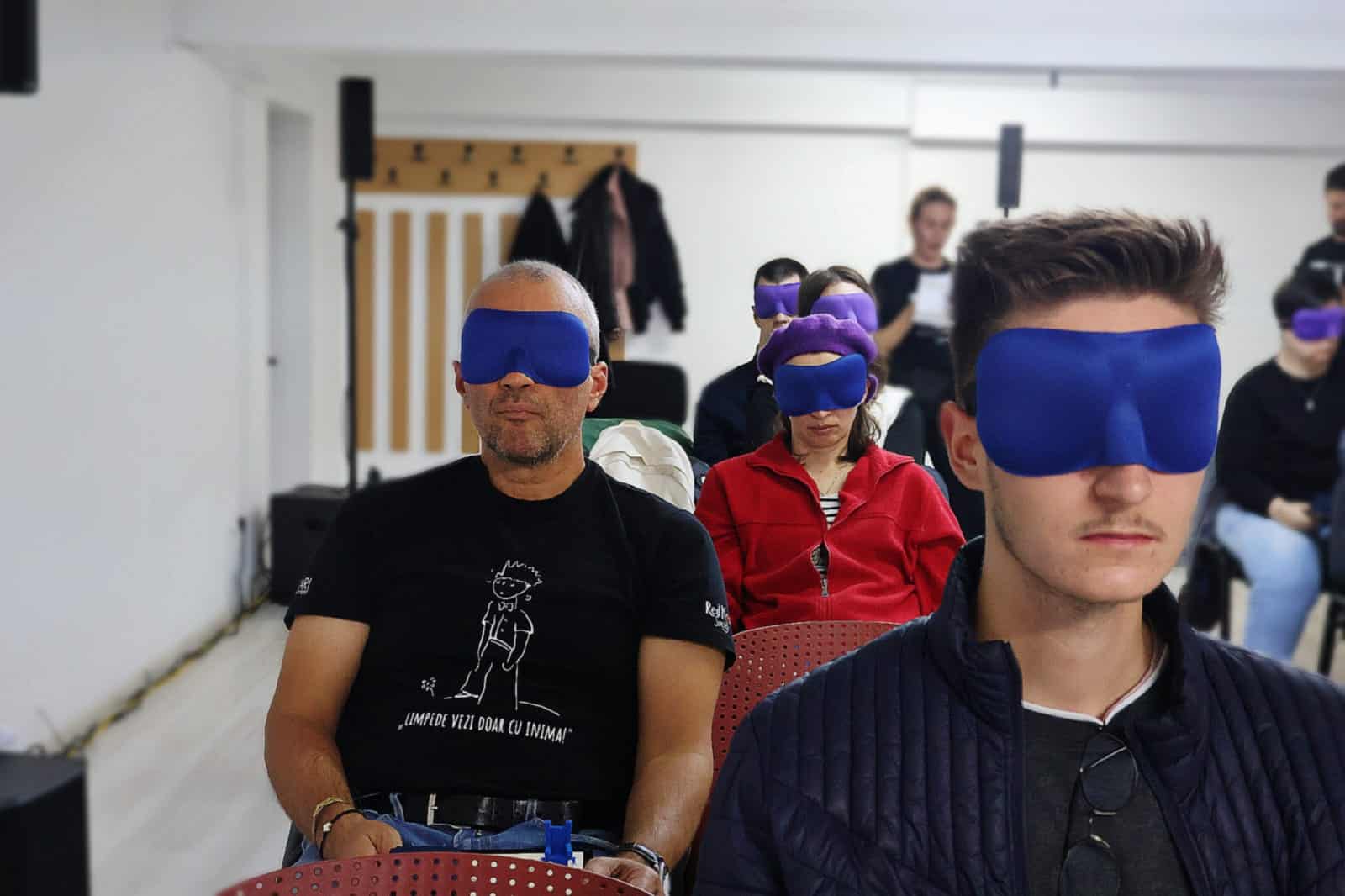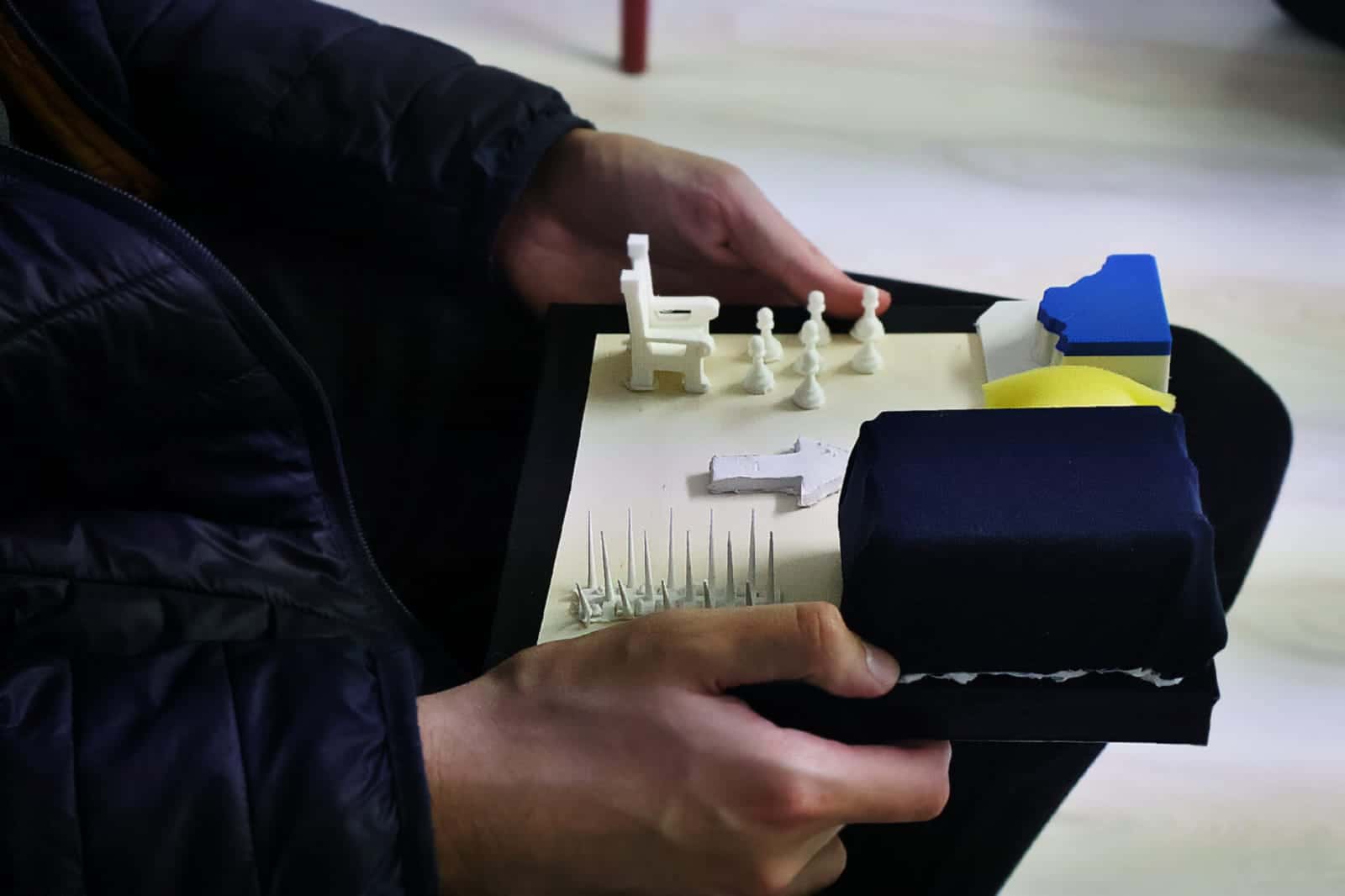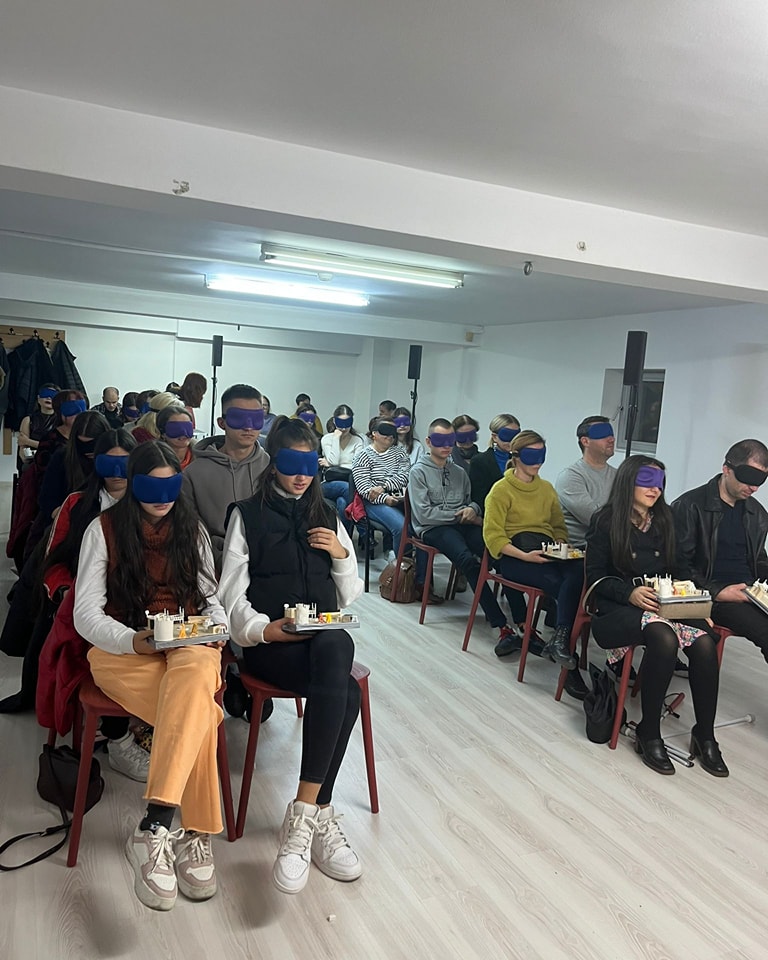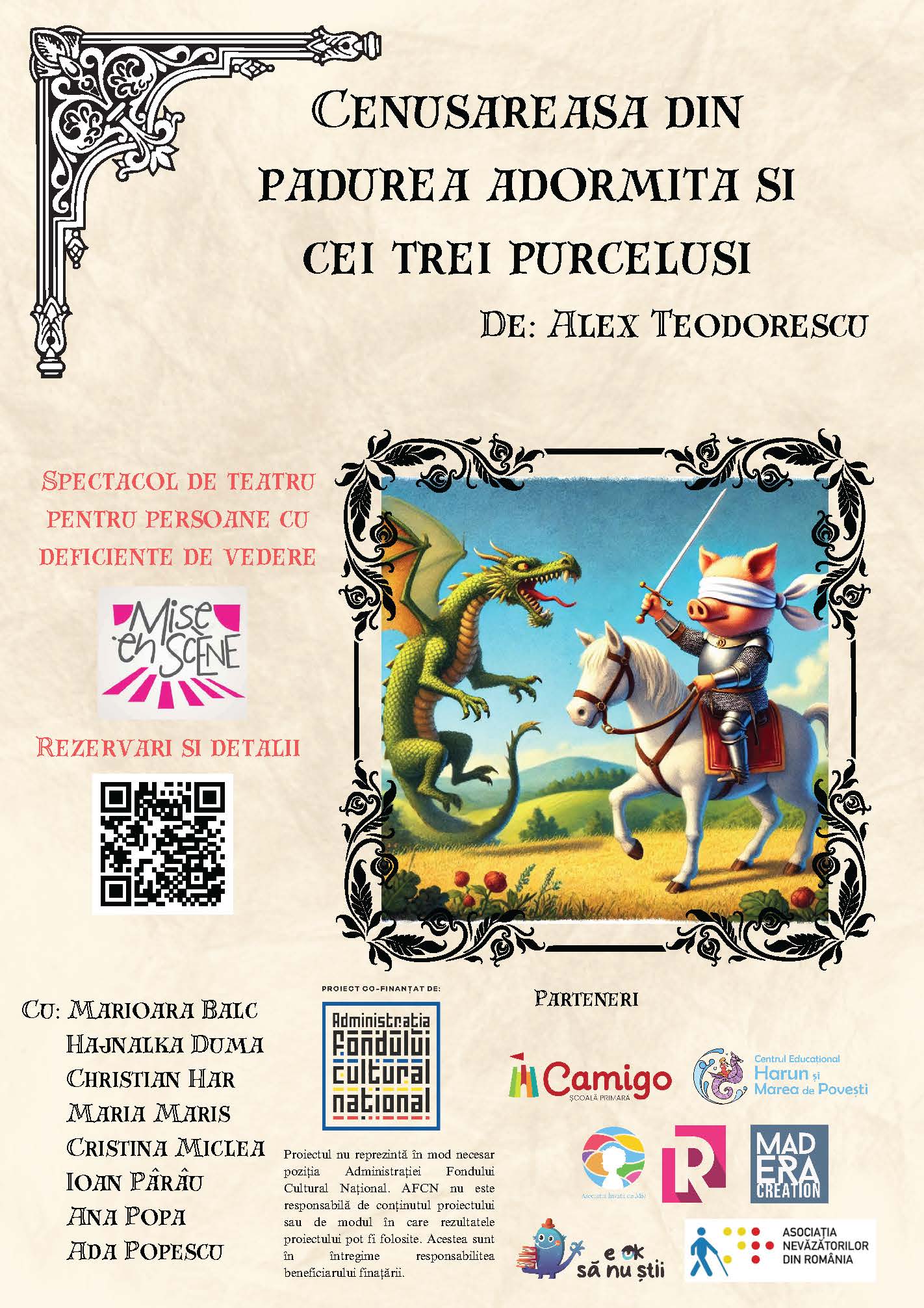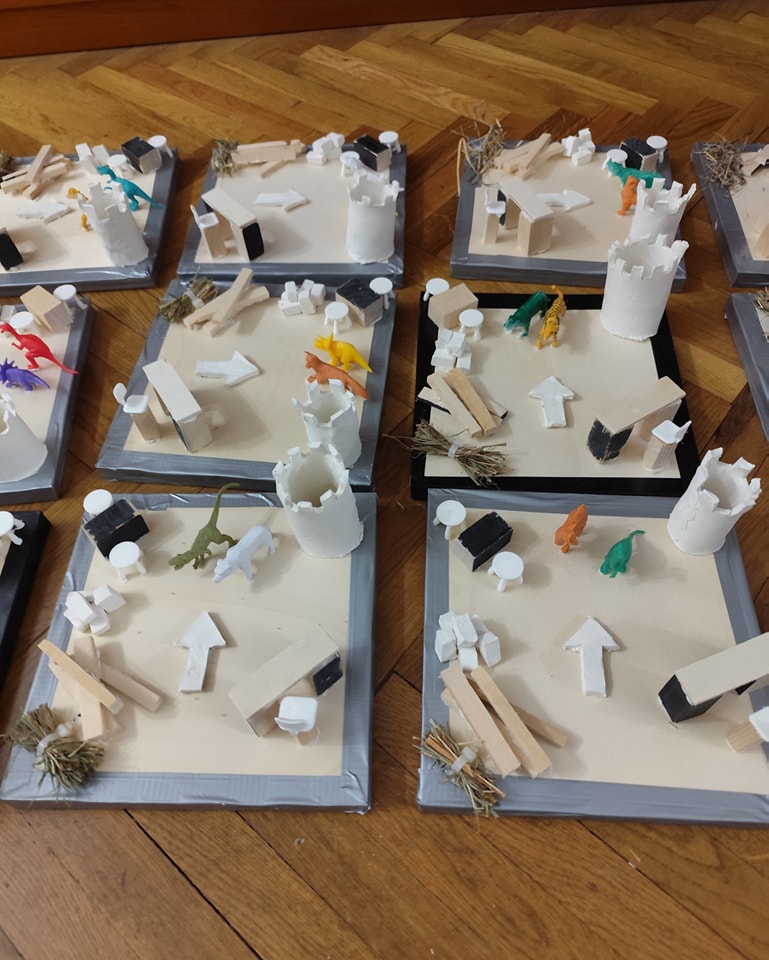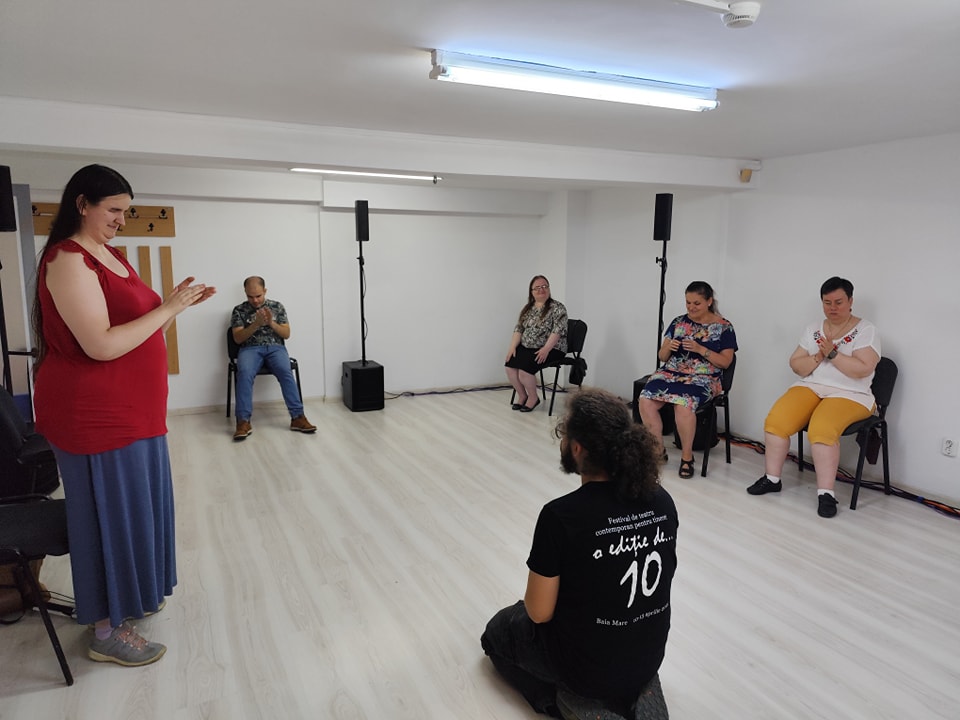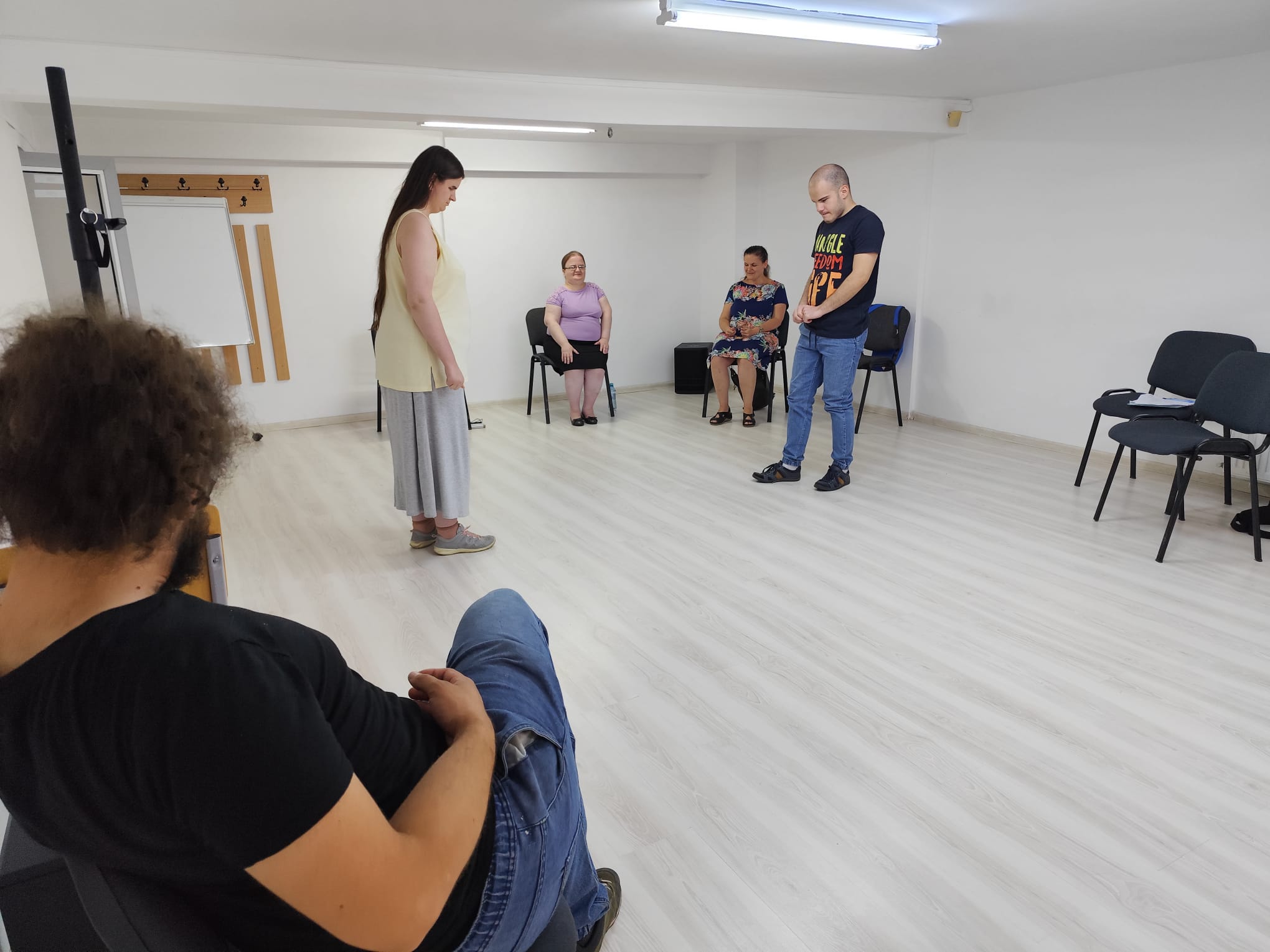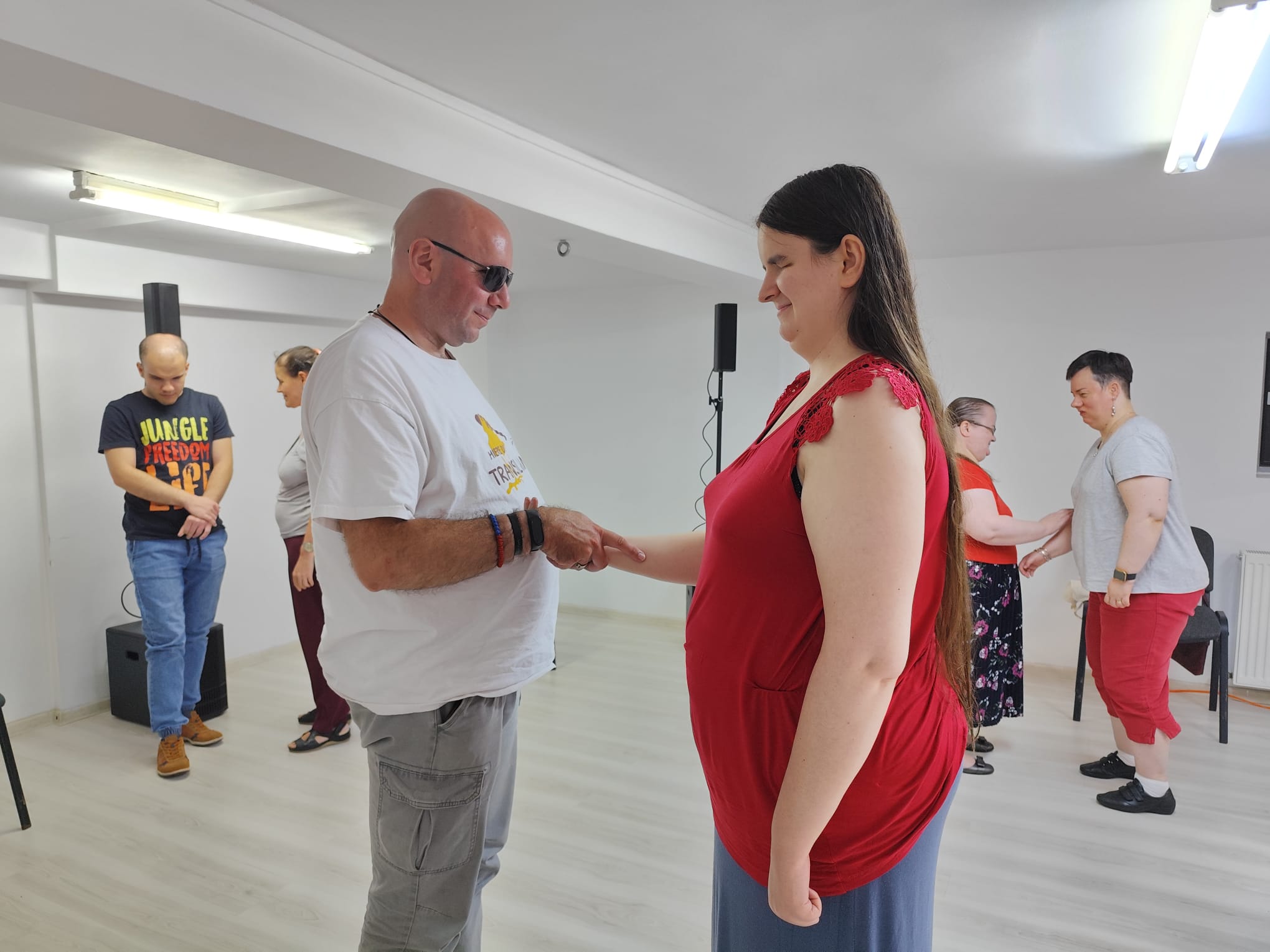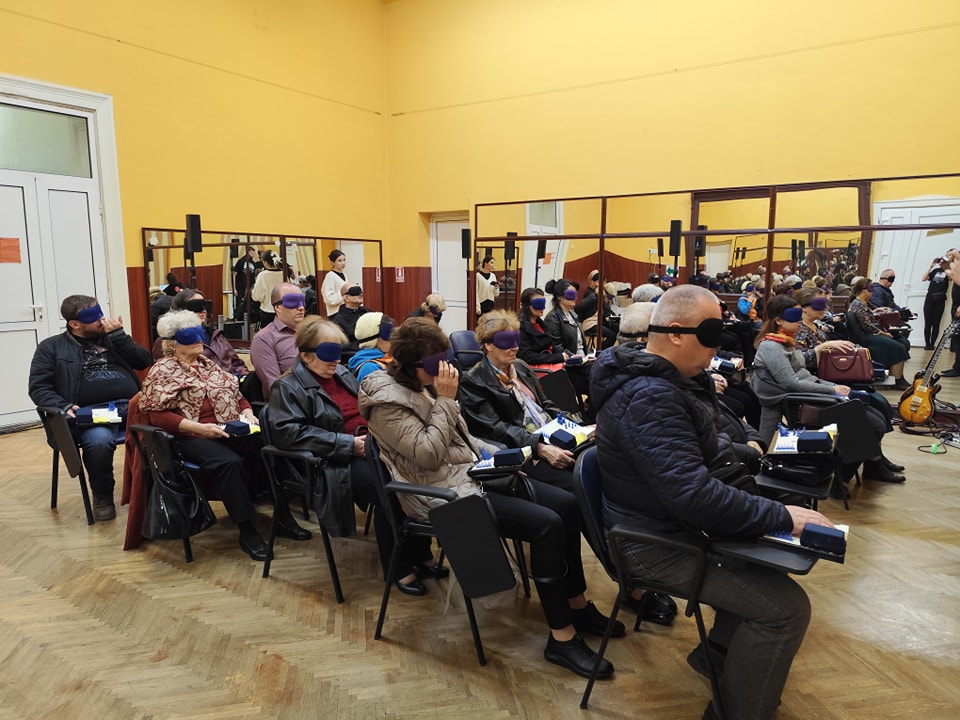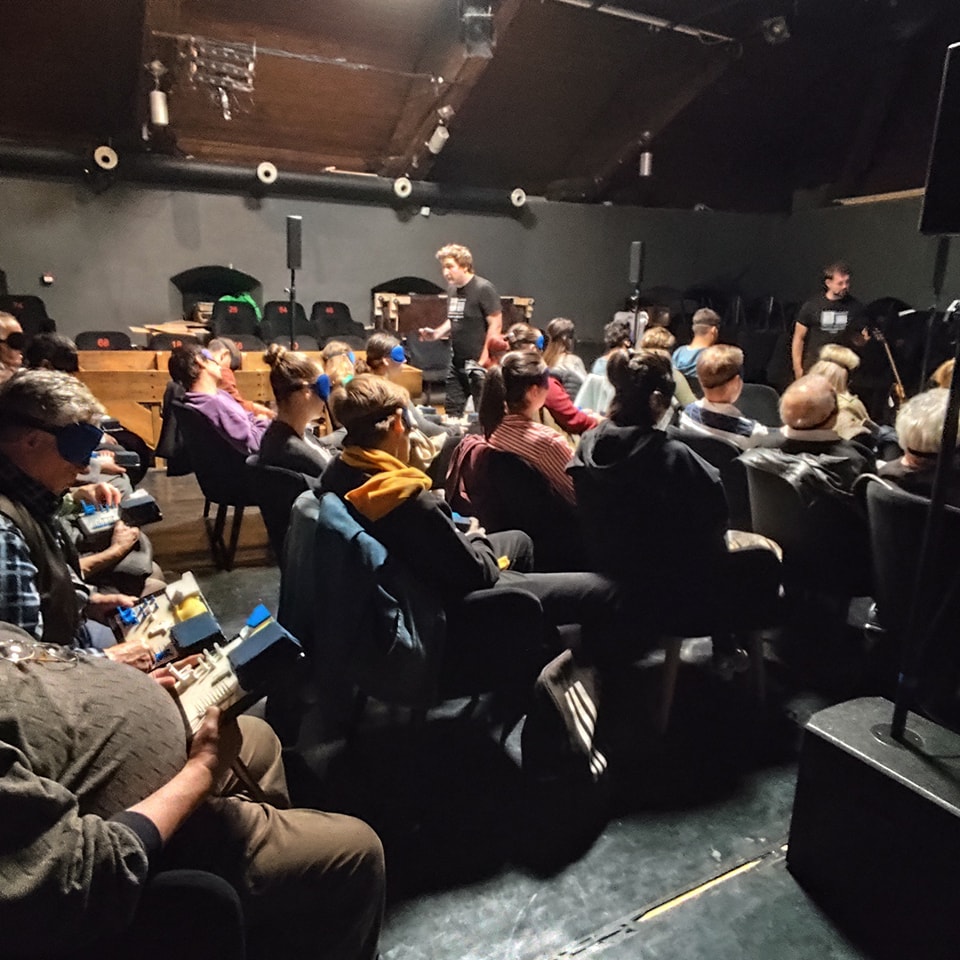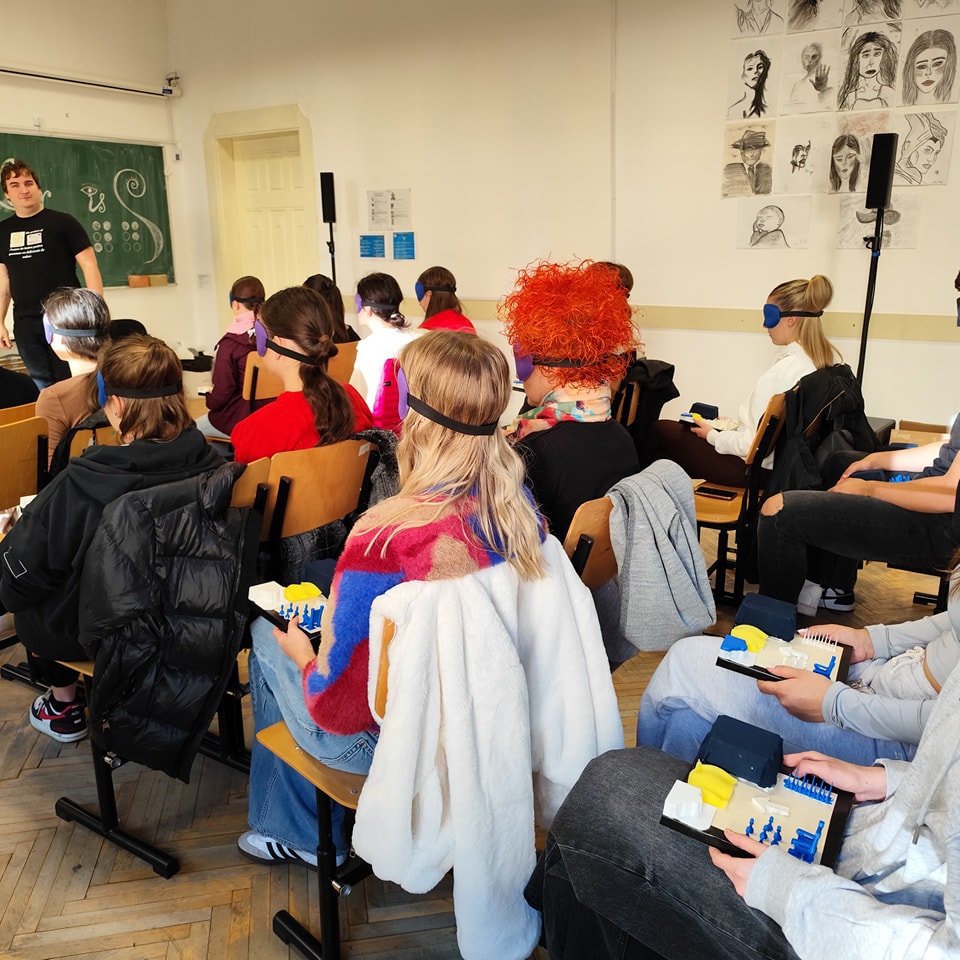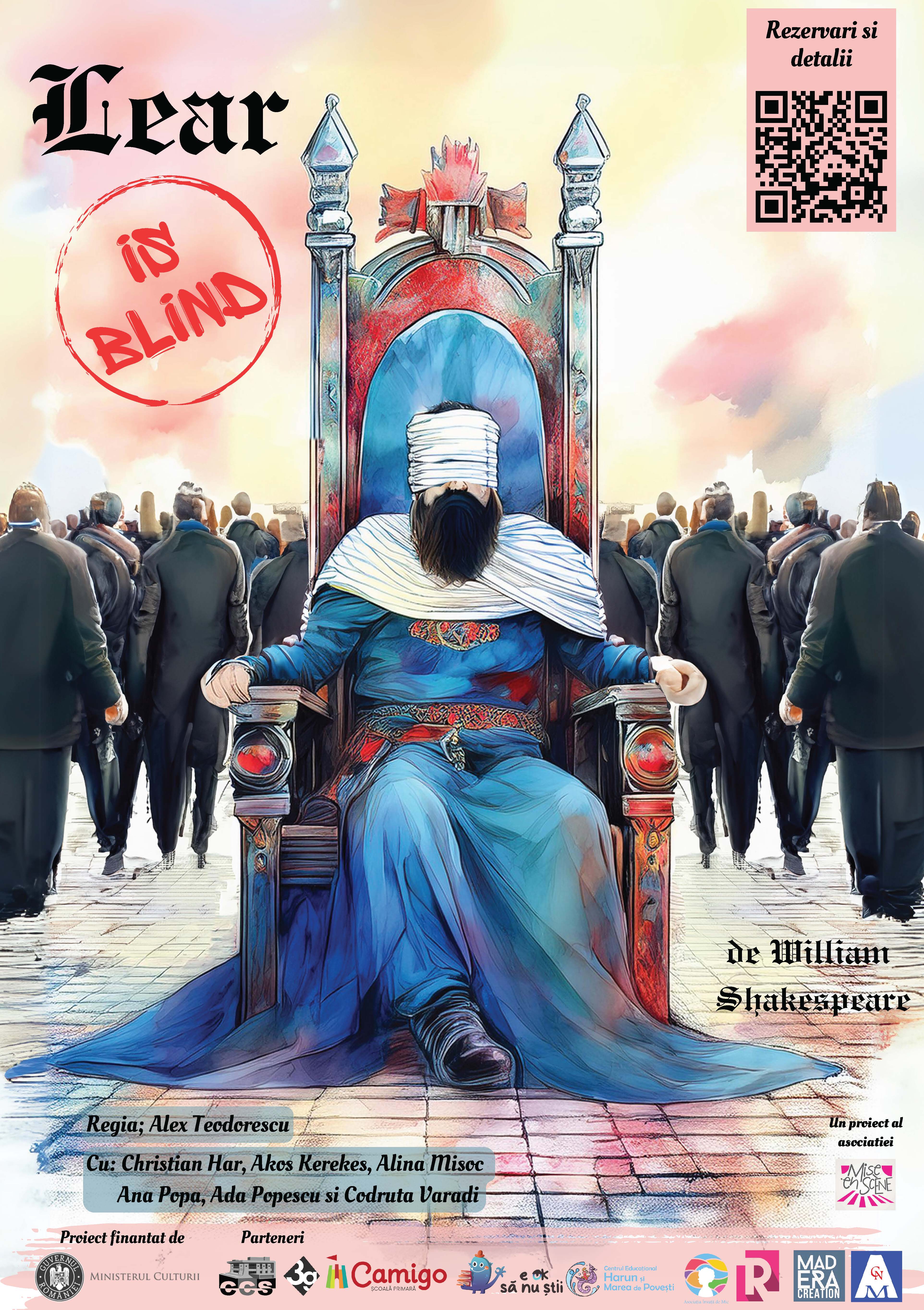Prioritising the places and people that need it the most
Hearing Theatre, Feeling Space
Hearing Theatre, Feeling Space: Redefining Accessibility
Hearing Theatre, Feeling Space transforms cultural access for the visually impaired in Cluj-Napoca. Building on Lear is Blind and Fără Lumină, we merge participatory theatre, surround sound, and tactile stage models to create an immersive, inclusive experience. By prioritizing people often excluded from the arts, we’re not just adapting theatre—we’re reimagining it, proving that culture should be felt, heard, and shared by all.
Romania
Regional
The project mainly took place in Cluj-Napoca, but it held events in other cities in the north-western region of the countrym, in cities such as Alba Iulia, Târgu Mureș or Bistrița
Mainly urban
It refers to other types of transformations (soft investment)
Yes
2024-11-12
No
No
No
As a representative of an organisation
Hearing Theatre, Feeling Space is a groundbreaking initiative dedicated to making theatre truly accessible for the visually impaired in Cluj-Napoca. Building on the success of Lear is Blind and Fără Lumină, the project combines participatory theatre, immersive surround sound, and tactile stage models to redefine cultural access and artistic inclusion.
Our overall aim is to establish a sustainable theatre model tailored to blind and visually impaired audiences, ensuring that they are not just passive spectators but active participants in cultural life. We believe that theatre is not only about what is seen but also about what is felt and heard. By designing performances that integrate soundscapes, live audio capture, and individual 3D-printed miniature stage sets, we create a fully immersive experience that enables visually impaired audiences to "see" through touch and sound.
Our target group is primarily the visually impaired community in Cluj-Napoca, a group often excluded from traditional cultural experiences due to a lack of accessible formats. We also address the general public, raising awareness about cultural exclusion and promoting inclusive artistic practices.
The specific objectives include:
- Developing and performing innovative, multisensory theatre productions accessible to visually impaired audiences.
- Expanding participatory theatre methods by involving blind individuals in the creative process, ensuring their perspectives shape the artistic outcome.
- Creating a replicable model for inclusive theatre that can be shared with cultural institutions and adapted in other cities.
Achieved outcomes so far include successful productions engaging over 280 visually impaired spectators in four cities, the development of a tactile-audio theatre methodology, and a growing movement advocating for accessible cultural spaces. This project prioritizes those most often left behind, proving that theatre can be felt, heard, and fully experienced by all.
Our overall aim is to establish a sustainable theatre model tailored to blind and visually impaired audiences, ensuring that they are not just passive spectators but active participants in cultural life. We believe that theatre is not only about what is seen but also about what is felt and heard. By designing performances that integrate soundscapes, live audio capture, and individual 3D-printed miniature stage sets, we create a fully immersive experience that enables visually impaired audiences to "see" through touch and sound.
Our target group is primarily the visually impaired community in Cluj-Napoca, a group often excluded from traditional cultural experiences due to a lack of accessible formats. We also address the general public, raising awareness about cultural exclusion and promoting inclusive artistic practices.
The specific objectives include:
- Developing and performing innovative, multisensory theatre productions accessible to visually impaired audiences.
- Expanding participatory theatre methods by involving blind individuals in the creative process, ensuring their perspectives shape the artistic outcome.
- Creating a replicable model for inclusive theatre that can be shared with cultural institutions and adapted in other cities.
Achieved outcomes so far include successful productions engaging over 280 visually impaired spectators in four cities, the development of a tactile-audio theatre methodology, and a growing movement advocating for accessible cultural spaces. This project prioritizes those most often left behind, proving that theatre can be felt, heard, and fully experienced by all.
visually-impaired
theatre
workshops
accesibility
inclusion
"Hearing Theatre, Feeling Space" ensures long-term cultural access for the visually impaired by creating a sustainable theatre model based on sound, touch, and participation. Traditional theatre relies on visuals, excluding blind audiences. This project redefines theatre by integrating surround sound, live audio description, and tactile stage models, making performances immersive and inclusive.
A key objective is developing a replicable methodology for inclusive theatre. By involving visually impaired individuals in workshops and script development, we ensure accessibility is built into the creative process. This participatory approach makes the model adaptable and sustainable for future productions.
The project also promotes social sustainability by engaging cultural institutions and policymakers, advocating for accessibility in mainstream programming. Providing a structured methodology ensures the impact extends beyond a single production, encouraging systemic change.
Scalability is another focus. The project’s format can be applied in other cities and adapted for different disabilities, making it a flexible and transferable model. Documenting and sharing the process helps spread inclusive theatre practices, fostering a broader cultural shift.
This initiative proves that accessibility in the arts is not an add-on but a fundamental change towards equity. By integrating visually impaired audiences into theatre, we create a sustainable framework for long-term inclusion, ensuring that culture can be fully experienced by all.
A key objective is developing a replicable methodology for inclusive theatre. By involving visually impaired individuals in workshops and script development, we ensure accessibility is built into the creative process. This participatory approach makes the model adaptable and sustainable for future productions.
The project also promotes social sustainability by engaging cultural institutions and policymakers, advocating for accessibility in mainstream programming. Providing a structured methodology ensures the impact extends beyond a single production, encouraging systemic change.
Scalability is another focus. The project’s format can be applied in other cities and adapted for different disabilities, making it a flexible and transferable model. Documenting and sharing the process helps spread inclusive theatre practices, fostering a broader cultural shift.
This initiative proves that accessibility in the arts is not an add-on but a fundamental change towards equity. By integrating visually impaired audiences into theatre, we create a sustainable framework for long-term inclusion, ensuring that culture can be fully experienced by all.
"Hearing Theatre, Feeling Space" redefines theatrical aesthetics by prioritizing the sensory experience of visually impaired audiences. Merging two distinct approaches from "Fără Lumină" and "Lear is Blind," the project explores both realism and abstraction, comedy and tragedy, offering diverse artistic experiences shaped by accessibility.
In "Fără Lumină," the stage-model was designed as a highly detailed, tactile model, allowing spectators to physically explore a realistic theatrical environment. The narrative followed a social comedic structure, making cultural themes accessible while fostering connection and humor. This approach aimed to create a familiar, engaging space where blind audiences could fully immerse themselves in a world built on touch and sound.
"Lear is Blind" took a different path, embracing abstraction in both stage design and storytelling. Instead of a highly detailed set, it relied on a minimal, symbolic tactile model that encouraged the audience to construct the space in their imagination. This, paired with a dramatic, tragedy-driven narrative, heightened emotional engagement and expanded the possibilities of non-visual storytelling. The result was a deeply immersive experience, where sound and texture became the primary vehicles of meaning.
Both productions used surround sound and live audio capture to create a dynamic, spatially aware soundscape, further enhancing immersion. Also, the specific artistic methodology we used is, as far as we know, unique worldwide. These aesthetic choices ensured that visually impaired audiences were not passive listeners but active participants, experiencing theatre in a way that values their perception.
By combining realism with abstraction, social comedy with tragedy, and tactile with auditory storytelling, the project expands the boundaries of inclusive theatre. It proves that accessibility does not limit artistic expression but enhances it, creating new aesthetic forms.
In "Fără Lumină," the stage-model was designed as a highly detailed, tactile model, allowing spectators to physically explore a realistic theatrical environment. The narrative followed a social comedic structure, making cultural themes accessible while fostering connection and humor. This approach aimed to create a familiar, engaging space where blind audiences could fully immerse themselves in a world built on touch and sound.
"Lear is Blind" took a different path, embracing abstraction in both stage design and storytelling. Instead of a highly detailed set, it relied on a minimal, symbolic tactile model that encouraged the audience to construct the space in their imagination. This, paired with a dramatic, tragedy-driven narrative, heightened emotional engagement and expanded the possibilities of non-visual storytelling. The result was a deeply immersive experience, where sound and texture became the primary vehicles of meaning.
Both productions used surround sound and live audio capture to create a dynamic, spatially aware soundscape, further enhancing immersion. Also, the specific artistic methodology we used is, as far as we know, unique worldwide. These aesthetic choices ensured that visually impaired audiences were not passive listeners but active participants, experiencing theatre in a way that values their perception.
By combining realism with abstraction, social comedy with tragedy, and tactile with auditory storytelling, the project expands the boundaries of inclusive theatre. It proves that accessibility does not limit artistic expression but enhances it, creating new aesthetic forms.
"Hearing Theatre, Feeling Space" places inclusion at its core, ensuring that visually impaired audiences are not only accommodated but fully integrated into the artistic experience. By prioritizing accessibility, affordability, and participation, the project sets a new standard for inclusive theatre and cultural engagement.
Accessibility is achieved through a multi-sensory approach. Performances combine surround sound, live audio capture, and tactile stage models, allowing blind spectators to construct a spatial and narrative understanding of the play. In "Fără Lumină," a detailed, realistic model of the stage provided a concrete reference, while "Lear is Blind" used an abstract model to encourage imaginative engagement. These approaches prove that accessibility can be diverse and artistically rich.
Affordability is another key aspect. All performances were free, financed through two national cultural financing systems, ensuring that financial barriers did not prevent participation. Additionally, performances were held in accessible venues, and partnerships with local organizations facilitated outreach to the visually impaired community, ensuring they were informed and involved.
Participation extends beyond the audience. The project actively involved blind individuals in workshops, script development, and feedback sessions, making them co-creators rather than passive spectators. Their insights directly shaped the final productions, aligning with the "design for all" principle.
This model challenges traditional theatre structures by demonstrating that inclusion enhances artistic quality rather than limiting it. By integrating accessibility from the start and engaging marginalized communities in the creative process, the project offers a replicable model for cultural institutions seeking to make the arts truly inclusive.It proves that when theatre is designed for everyone, it becomes richer, more innovative, and deeply meaningful.
Accessibility is achieved through a multi-sensory approach. Performances combine surround sound, live audio capture, and tactile stage models, allowing blind spectators to construct a spatial and narrative understanding of the play. In "Fără Lumină," a detailed, realistic model of the stage provided a concrete reference, while "Lear is Blind" used an abstract model to encourage imaginative engagement. These approaches prove that accessibility can be diverse and artistically rich.
Affordability is another key aspect. All performances were free, financed through two national cultural financing systems, ensuring that financial barriers did not prevent participation. Additionally, performances were held in accessible venues, and partnerships with local organizations facilitated outreach to the visually impaired community, ensuring they were informed and involved.
Participation extends beyond the audience. The project actively involved blind individuals in workshops, script development, and feedback sessions, making them co-creators rather than passive spectators. Their insights directly shaped the final productions, aligning with the "design for all" principle.
This model challenges traditional theatre structures by demonstrating that inclusion enhances artistic quality rather than limiting it. By integrating accessibility from the start and engaging marginalized communities in the creative process, the project offers a replicable model for cultural institutions seeking to make the arts truly inclusive.It proves that when theatre is designed for everyone, it becomes richer, more innovative, and deeply meaningful.
"Hearing Theatre, Feeling Space" was shaped through direct collaboration with the visually impaired community, ensuring their needs and perspectives were central to the artistic and technical design. Their involvement extended beyond audience participation, making them active contributors to the creative process.
From the outset, citizens with visual impairments were engaged through workshops, discussions, and creative sessions. In "Lear is Blind," blind participants helped shape the narrative by sharing their personal experiences, which directly influenced the script. This participatory approach ensured the story resonated with their reality and offered an authentic voice to issues they face. Their feedback also guided the development of the abstract stage model, refining how space was represented through touch and sound.
"Fără Lumină" took a more production-focused approach, incorporating visually impaired individuals as co-creators and performers. Their insights informed the realism of the tactile model, ensuring that spatial representation was both functional and artistically engaging. The comedic structure of the play was also refined through their input, balancing humor with meaningful commentary on accessibility and societal perceptions of disability.
Civil society organizations, including associations for the blind, played a crucial role in outreach, ensuring that performances and workshops reached those who would benefit most. These partnerships also helped shape accessibility strategies, such as optimizing sound placement and ensuring affordability.
This deep involvement had a profound impact on the project, making it a truly inclusive cultural initiative. It ensured that accessibility was not an afterthought but a fundamental design principle. By directly engaging those affected, the project created theatre that did not just accommodate but actively reflected their experiences, setting a precedent for inclusive cultural production.
From the outset, citizens with visual impairments were engaged through workshops, discussions, and creative sessions. In "Lear is Blind," blind participants helped shape the narrative by sharing their personal experiences, which directly influenced the script. This participatory approach ensured the story resonated with their reality and offered an authentic voice to issues they face. Their feedback also guided the development of the abstract stage model, refining how space was represented through touch and sound.
"Fără Lumină" took a more production-focused approach, incorporating visually impaired individuals as co-creators and performers. Their insights informed the realism of the tactile model, ensuring that spatial representation was both functional and artistically engaging. The comedic structure of the play was also refined through their input, balancing humor with meaningful commentary on accessibility and societal perceptions of disability.
Civil society organizations, including associations for the blind, played a crucial role in outreach, ensuring that performances and workshops reached those who would benefit most. These partnerships also helped shape accessibility strategies, such as optimizing sound placement and ensuring affordability.
This deep involvement had a profound impact on the project, making it a truly inclusive cultural initiative. It ensured that accessibility was not an afterthought but a fundamental design principle. By directly engaging those affected, the project created theatre that did not just accommodate but actively reflected their experiences, setting a precedent for inclusive cultural production.
"Hearing Theatre, Feeling Space" was built on strong collaborations with stakeholders at multiple levels, ensuring its success as an inclusive cultural initiative.
At the local level, the NGO for the visually impaired in Cluj played a crucial role in outreach and feedback. They facilitated direct engagement with blind individuals, ensuring their participation in workshops, script development, and performances. Their input helped refine accessibility strategies, such as optimizing tactile models and surround sound placement.
Educational NGOs, such as Învață de Mic, contributed by integrating participatory methods into the project. They organized workshops, offering expertise in inclusive education and creative engagement. Their involvement ensured that visually impaired participants were not just passive audiences but active co-creators.
Cultural producers, such as Madera Creation, supported the project through technical expertise and documentation. They helped adapt immersive sound techniques and recorded performances, ensuring accessibility beyond live events. Their involvement allowed the project to extend its reach through digital formats, making it sustainable and replicable.
Local businesses, such as Marea de Povești SRL, played a key role in promotion and logistical support. Their experience in marketing helped raise awareness about the performances and workshops, ensuring strong community participation.
At the national level, two major state actors provided essential financial support. The Ministry of Culture and the National Cultural Fund Administration funded the development and execution of both projects, recognizing their value in advancing cultural accessibility. Their backing not only ensured implementation but also set a precedent for state-supported inclusive theatre.
The collaboration across sectors ensured a well-rounded, sustainable model for inclusive theatre, demonstrating how multi-level engagement drives meaningful cultural change.
At the local level, the NGO for the visually impaired in Cluj played a crucial role in outreach and feedback. They facilitated direct engagement with blind individuals, ensuring their participation in workshops, script development, and performances. Their input helped refine accessibility strategies, such as optimizing tactile models and surround sound placement.
Educational NGOs, such as Învață de Mic, contributed by integrating participatory methods into the project. They organized workshops, offering expertise in inclusive education and creative engagement. Their involvement ensured that visually impaired participants were not just passive audiences but active co-creators.
Cultural producers, such as Madera Creation, supported the project through technical expertise and documentation. They helped adapt immersive sound techniques and recorded performances, ensuring accessibility beyond live events. Their involvement allowed the project to extend its reach through digital formats, making it sustainable and replicable.
Local businesses, such as Marea de Povești SRL, played a key role in promotion and logistical support. Their experience in marketing helped raise awareness about the performances and workshops, ensuring strong community participation.
At the national level, two major state actors provided essential financial support. The Ministry of Culture and the National Cultural Fund Administration funded the development and execution of both projects, recognizing their value in advancing cultural accessibility. Their backing not only ensured implementation but also set a precedent for state-supported inclusive theatre.
The collaboration across sectors ensured a well-rounded, sustainable model for inclusive theatre, demonstrating how multi-level engagement drives meaningful cultural change.
"Hearing Theatre, Feeling Space" integrated theatre, sound design, tactile modeling, education, accessibility studies, marketing, communication, and event management to create an inclusive, multisensory cultural model.
Theatre professionals developed narratives accessible through sound and touch. "Lear is Blind" collaborated with visually impaired participants to shape an abstract approach, while "Fără Lumină" used realism and comedy to enhance engagement.
Sound designers created immersive audio environments, using surround sound and live audio capture to guide audiences through the story. Their expertise ensured that sound became a primary storytelling tool.
Tactile modeling specialists designed physical stage models, allowing audiences to explore theatre through touch. "Fără Lumină" used realism, while "Lear is Blind" employed abstraction to stimulate imagination.
Educators and accessibility experts from Asociația Învață de Mic structured participatory workshops, ensuring visually impaired individuals contributed directly to the creative process. Their input refined the project’s inclusive design.
Marketing and communication specialists, including Marea de Povești SRL, played a key role in outreach, ensuring the project reached both target audiences and the general public. Their efforts helped increase awareness of inclusive theatre.
Event organizers managed logistics and audience engagement, ensuring performances were accessible, well-promoted, and smoothly executed. They collaborated with cultural producers like Madera Creation to enhance the audience experience.
This interdisciplinary collaboration enriched every aspect of the project. By blending artistic, technical, and strategic expertise, the initiative set a new standard for inclusive theatre, proving that accessibility enhances, rather than limits, artistic innovation.
Theatre professionals developed narratives accessible through sound and touch. "Lear is Blind" collaborated with visually impaired participants to shape an abstract approach, while "Fără Lumină" used realism and comedy to enhance engagement.
Sound designers created immersive audio environments, using surround sound and live audio capture to guide audiences through the story. Their expertise ensured that sound became a primary storytelling tool.
Tactile modeling specialists designed physical stage models, allowing audiences to explore theatre through touch. "Fără Lumină" used realism, while "Lear is Blind" employed abstraction to stimulate imagination.
Educators and accessibility experts from Asociația Învață de Mic structured participatory workshops, ensuring visually impaired individuals contributed directly to the creative process. Their input refined the project’s inclusive design.
Marketing and communication specialists, including Marea de Povești SRL, played a key role in outreach, ensuring the project reached both target audiences and the general public. Their efforts helped increase awareness of inclusive theatre.
Event organizers managed logistics and audience engagement, ensuring performances were accessible, well-promoted, and smoothly executed. They collaborated with cultural producers like Madera Creation to enhance the audience experience.
This interdisciplinary collaboration enriched every aspect of the project. By blending artistic, technical, and strategic expertise, the initiative set a new standard for inclusive theatre, proving that accessibility enhances, rather than limits, artistic innovation.
Traditional theatre often relies on audio description or occasional touch tours, which, while useful, still position visually impaired audiences as secondary participants. This project, however, redefines theatre as a multisensory experience, where sound, touch, and spatial perception replace sight as the primary means of engagement.
A key innovation is the use of surround sound and live audio capture. Instead of a simple descriptive voice-over, the sound design itself creates an immersive world where characters, movement, and atmosphere are spatially perceived. This approach allows visually impaired audiences to "see" through sound, offering a richer, more dynamic experience.
The introduction of tactile stage models further enhances accessibility. Unlike standard productions that rely solely on verbal explanations, each spectator is given a miniature 3D-printed set to explore before and during the performance. "Fără Lumină" used a detailed, realistic model, while "Lear is Blind" opted for a more abstract representation, demonstrating how different spatial concepts can be adapted for non-visual storytelling.
Another breakthrough is the participatory approach. Visually impaired individuals were not just spectators but co-creators, influencing the narrative, stage design, and performance style. This challenges mainstream practices, where accessibility is often addressed from an external perspective rather than shaped by those it affects directly.
Adhering to the idea that both shows and projects were created for the blind, all non-visually impaired participants were asked to wear blindfolds, creating an immersive experience into the world of the non-seers. We thus created a change of paradigm – from a visual theatre accessible to the blind, to a theatre for the blind accessible for the seers.
A key innovation is the use of surround sound and live audio capture. Instead of a simple descriptive voice-over, the sound design itself creates an immersive world where characters, movement, and atmosphere are spatially perceived. This approach allows visually impaired audiences to "see" through sound, offering a richer, more dynamic experience.
The introduction of tactile stage models further enhances accessibility. Unlike standard productions that rely solely on verbal explanations, each spectator is given a miniature 3D-printed set to explore before and during the performance. "Fără Lumină" used a detailed, realistic model, while "Lear is Blind" opted for a more abstract representation, demonstrating how different spatial concepts can be adapted for non-visual storytelling.
Another breakthrough is the participatory approach. Visually impaired individuals were not just spectators but co-creators, influencing the narrative, stage design, and performance style. This challenges mainstream practices, where accessibility is often addressed from an external perspective rather than shaped by those it affects directly.
Adhering to the idea that both shows and projects were created for the blind, all non-visually impaired participants were asked to wear blindfolds, creating an immersive experience into the world of the non-seers. We thus created a change of paradigm – from a visual theatre accessible to the blind, to a theatre for the blind accessible for the seers.
The project is based on a participatory and multisensory approach, ensuring that theatre for visually impaired audiences is not just accessible but designed specifically for their perception.
1. Participatory Creation Process
Unlike traditional productions where accessibility is added later, this project begins with direct input from visually impaired individuals. Through workshops and discussions, they contribute insights on spatial awareness, storytelling techniques, and emotional engagement. In "Lear is Blind," this input shaped an abstract dramaturgy, while "Fără Lumină" used their feedback to refine a realistic comedic narrative.
2. Multisensory Storytelling
Instead of relying on visual staging, the performances use surround sound and live audio capture to create a spatialized audio experience. Sound replaces sight as the primary storytelling tool, allowing audiences to perceive movement, distance, and atmosphere dynamically.
3. Tactile Spatial Representation
Each spectator is given a 3D-printed miniature stage model, which they can explore before and during the performance. This enhances spatial perception, replacing visual cues with touch-based scene comprehension.
4. Co-creation and Real-Time Adaptation
Actors and directors work closely with accessibility experts to adjust performances based on audience feedback. Scenes are tested in workshops with visually impaired participants, refining the sensory balance between dialogue, sound effects, and spatial cues.
5. Scalability and Replicability
The methodology is designed for adaptation in other cities and theatre settings. The project documents its process, creating a model that cultural institutions can implement to make theatre universally accessible.
By integrating accessibility at every level, the project proves that inclusion is not a constraint but a driving force for artistic and methodological innovation
1. Participatory Creation Process
Unlike traditional productions where accessibility is added later, this project begins with direct input from visually impaired individuals. Through workshops and discussions, they contribute insights on spatial awareness, storytelling techniques, and emotional engagement. In "Lear is Blind," this input shaped an abstract dramaturgy, while "Fără Lumină" used their feedback to refine a realistic comedic narrative.
2. Multisensory Storytelling
Instead of relying on visual staging, the performances use surround sound and live audio capture to create a spatialized audio experience. Sound replaces sight as the primary storytelling tool, allowing audiences to perceive movement, distance, and atmosphere dynamically.
3. Tactile Spatial Representation
Each spectator is given a 3D-printed miniature stage model, which they can explore before and during the performance. This enhances spatial perception, replacing visual cues with touch-based scene comprehension.
4. Co-creation and Real-Time Adaptation
Actors and directors work closely with accessibility experts to adjust performances based on audience feedback. Scenes are tested in workshops with visually impaired participants, refining the sensory balance between dialogue, sound effects, and spatial cues.
5. Scalability and Replicability
The methodology is designed for adaptation in other cities and theatre settings. The project documents its process, creating a model that cultural institutions can implement to make theatre universally accessible.
By integrating accessibility at every level, the project proves that inclusion is not a constraint but a driving force for artistic and methodological innovation
The project offers a replicable model that can be transferred to other cities, cultural institutions, and marginalized groups.
The methodology of integrating visually impaired individuals into the creative process can be applied to any theatre production aiming for inclusivity. The participatory workshops, where blind audiences contribute to script development and spatial representation, ensure that accessibility is embedded from the start rather than added as an afterthought. This model can be adapted to different communities, including people with other disabilities or those facing cultural exclusion.
The use of tactile stage models is another transferable aspect. The concept of offering audiences a physical representation of the stage can be applied to various art forms, from theatre to museums and exhibitions. Whether using realistic or abstract models, this method enhances spatial awareness and engagement, benefiting not only blind individuals but also children, neurodivergent audiences, or those unfamiliar with certain cultural references.
The immersive sound design, which replaces visual elements with surround sound and live audio capture, is easily adaptable to different performance styles and venues. This technique can be used in radio theatre, audiobooks, or interactive digital storytelling, broadening access to culture for those who rely on auditory perception.
Additionally, the project's approach to affordability and accessibility—offering free or low-cost performances, collaborating with local NGOs, and ensuring transport accessibility—can serve as a model for other cultural initiatives. By prioritizing inclusion at every stage, this project demonstrates that accessibility does not limit artistic expression but enhances it.
With proper documentation and training, this model can be expanded to other cities, theatre companies, and cultural spaces, ensuring that meaningful, sensory-rich theatre experiences are available to diverse audiences worldwide
The methodology of integrating visually impaired individuals into the creative process can be applied to any theatre production aiming for inclusivity. The participatory workshops, where blind audiences contribute to script development and spatial representation, ensure that accessibility is embedded from the start rather than added as an afterthought. This model can be adapted to different communities, including people with other disabilities or those facing cultural exclusion.
The use of tactile stage models is another transferable aspect. The concept of offering audiences a physical representation of the stage can be applied to various art forms, from theatre to museums and exhibitions. Whether using realistic or abstract models, this method enhances spatial awareness and engagement, benefiting not only blind individuals but also children, neurodivergent audiences, or those unfamiliar with certain cultural references.
The immersive sound design, which replaces visual elements with surround sound and live audio capture, is easily adaptable to different performance styles and venues. This technique can be used in radio theatre, audiobooks, or interactive digital storytelling, broadening access to culture for those who rely on auditory perception.
Additionally, the project's approach to affordability and accessibility—offering free or low-cost performances, collaborating with local NGOs, and ensuring transport accessibility—can serve as a model for other cultural initiatives. By prioritizing inclusion at every stage, this project demonstrates that accessibility does not limit artistic expression but enhances it.
With proper documentation and training, this model can be expanded to other cities, theatre companies, and cultural spaces, ensuring that meaningful, sensory-rich theatre experiences are available to diverse audiences worldwide
The project addresses the global challenge of cultural exclusion by providing a local solution that makes theatre fully accessible to visually impaired audiences. Around the world, people with disabilities face significant barriers to cultural participation, as traditional artistic institutions often prioritize visual experiences. This project challenges that norm by designing theatre that can be fully experienced through sound and touch, ensuring that blind and visually impaired individuals are not just accommodated but actively engaged.
One major global issue is the lack of inclusive cultural policies. Many accessibility initiatives focus on providing adaptations rather than creating cultural products designed for marginalized communities from the outset. This project offers a model where accessibility is embedded into the creative process, proving that inclusion can be a driver of artistic innovation rather than a limitation.
Another challenge is the limited representation of visually impaired individuals in cultural narratives and production. By involving them as co-creators, the project shifts the perspective from passive spectatorship to active participation. The stories told on stage reflect real experiences, promoting a more diverse and accurate representation of disability in the arts.
The technological gap in accessibility is another global concern. While many cultural institutions struggle to implement effective assistive technologies, this project demonstrates a cost-effective, scalable approach through surround sound storytelling and tactile stage models. These elements do not require expensive equipment, making them easily replicable in other contexts.
The project also addresses the need for affordable cultural access. Many people with disabilities face economic challenges that limit their participation in cultural events. By offering free or low-cost performances, this model ensures that accessibility includes financial inclusion.
One major global issue is the lack of inclusive cultural policies. Many accessibility initiatives focus on providing adaptations rather than creating cultural products designed for marginalized communities from the outset. This project offers a model where accessibility is embedded into the creative process, proving that inclusion can be a driver of artistic innovation rather than a limitation.
Another challenge is the limited representation of visually impaired individuals in cultural narratives and production. By involving them as co-creators, the project shifts the perspective from passive spectatorship to active participation. The stories told on stage reflect real experiences, promoting a more diverse and accurate representation of disability in the arts.
The technological gap in accessibility is another global concern. While many cultural institutions struggle to implement effective assistive technologies, this project demonstrates a cost-effective, scalable approach through surround sound storytelling and tactile stage models. These elements do not require expensive equipment, making them easily replicable in other contexts.
The project also addresses the need for affordable cultural access. Many people with disabilities face economic challenges that limit their participation in cultural events. By offering free or low-cost performances, this model ensures that accessibility includes financial inclusion.
One of the key outcomes was the successful engagement of over 280 visually impaired spectators across performances of Lear is Blind and Fără Lumină. These audiences experienced theatre in a way specifically designed for their perception, rather than as an adaptation of a mainstream production. The project also involved direct participation from visually impaired individuals in script development and staging, ensuring their voices and experiences shaped the performances.
A major impact of the project is the increased awareness of cultural exclusion among the general public. By including sighted individuals in performances structured for blind audiences, the project created opportunities for empathy and dialogue. It challenged conventional notions of how theatre is experienced and encouraged broader discussions on accessibility in the arts.
Another key result is the development of an innovative, multisensory theatre methodology that can be replicated elsewhere. The combination of surround sound, live audio capture, and tactile stage models has proven to be a successful approach to immersive storytelling for blind audiences. This methodology has been documented and shared with cultural institutions and accessibility organizations, ensuring long-term impact.
Beyond the immediate beneficiaries, the project has influenced local cultural policies and partnerships. Collaborations with NGOs, educators, and cultural producers have strengthened networks supporting accessibility in the arts. It has also set a precedent for how state funding can be directed toward inclusive cultural projects, encouraging future investment in accessibility-driven theatre.
By prioritizing a marginalized community and demonstrating a replicable model of inclusion, Hearing Theatre, Feeling Space has created a lasting impact, proving that accessible culture is not a niche effort but an essential step toward cultural equity.
A major impact of the project is the increased awareness of cultural exclusion among the general public. By including sighted individuals in performances structured for blind audiences, the project created opportunities for empathy and dialogue. It challenged conventional notions of how theatre is experienced and encouraged broader discussions on accessibility in the arts.
Another key result is the development of an innovative, multisensory theatre methodology that can be replicated elsewhere. The combination of surround sound, live audio capture, and tactile stage models has proven to be a successful approach to immersive storytelling for blind audiences. This methodology has been documented and shared with cultural institutions and accessibility organizations, ensuring long-term impact.
Beyond the immediate beneficiaries, the project has influenced local cultural policies and partnerships. Collaborations with NGOs, educators, and cultural producers have strengthened networks supporting accessibility in the arts. It has also set a precedent for how state funding can be directed toward inclusive cultural projects, encouraging future investment in accessibility-driven theatre.
By prioritizing a marginalized community and demonstrating a replicable model of inclusion, Hearing Theatre, Feeling Space has created a lasting impact, proving that accessible culture is not a niche effort but an essential step toward cultural equity.

